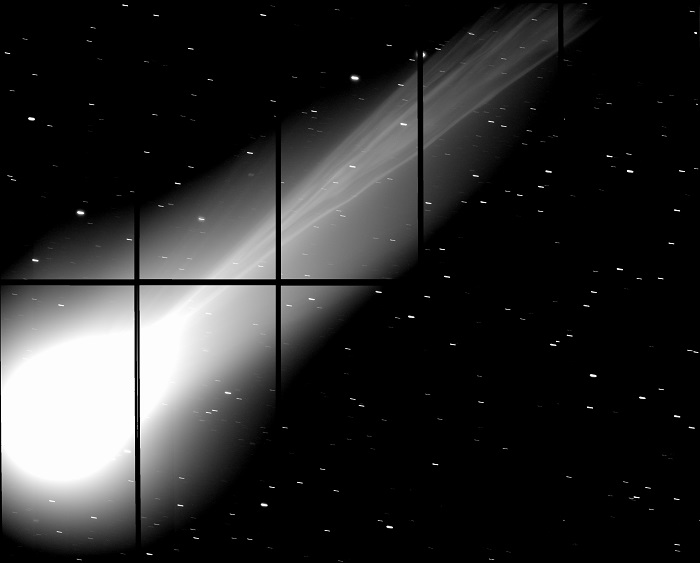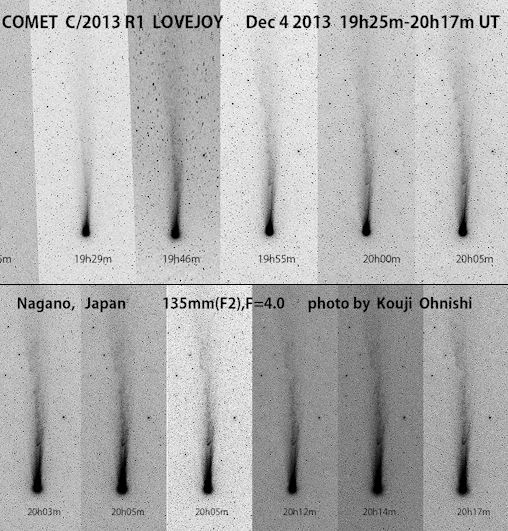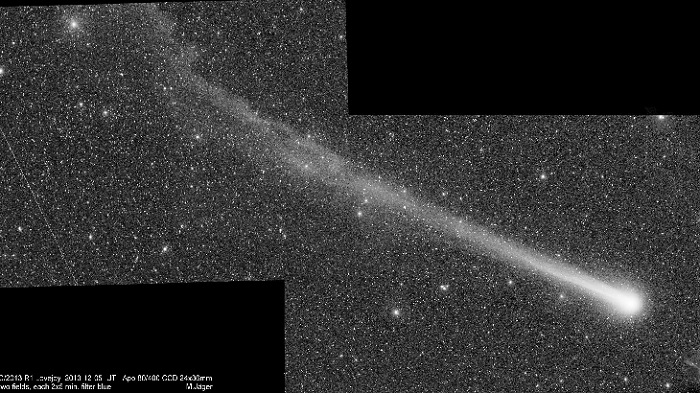.
A team of astronomers from Stony Brook University (the State University of New York at Stony Brook), the National Astronomical Observatory of Japan (NAOJ), and others used Suprime-Cam, Subaru Telescope's wide-field, prime-focus camera, to capture an image of the intricate flow of Comet Lovejoy's (C/2013 R1) ion tail. (Figure 1) The instrument's combination of a wide field of view and high spatial resolution provides a clear delineation of the complex, wiggling streams in the comet's tail. At the time of this observation, at around 5:30 am on December 3, 2013 (Hawaii Standard Time), Comet Lovejoy was 50 million miles (80 million km) distant from Earth and 80 million miles (130 million km) away from the Sun.
.

Figure 1: Image of Comet Lovejoy (C/2013 R1) captured by the Subaru Telescope's Suprime-Cam on December 3, 2013 (Hawaii Standard Time). The wavelength was at 450 nm (B-band), with a 180 second exposure. (Credit: NAOJ with data processing by Masafumi Yagi (NAOJ))
.
Comet Lovejoy was discovered in September this year (2013). At dawn on October 31, 2013, Subaru Telescope succeeded in capturing its image, which showed dust jets streaming from its nucleus. (Subaru Telescope Captures Visible-Light Images of the Comets ISON and Lovejoy) Although Comet ISON (C2012 S1) did not survive its closest encounter with the Sun (its perihelion) at the end of November (2013), Comet Lovejoy's visibility has been increasing in the eastern sky. The current image adds even more data about this newly-discovered comet. The variety of approaches used to image and analyze Comet Lovejoy will lead to a much clearer view of its detailed structure. As a member of the observation team commented, "Subaru Telescope offers a rare combination of large telescope aperture and a wide-field camera. This enabled us to capture a detailed look at the nucleus while also photogenically framing inner portions of Comet Lovejoy's impressive ion tail." (Figure 2)
.

Figure 2: Scientists in Subaru Telescope’s control room checking the details of Comet Lovejoy from the image that Suprime-Cam successfully captured. From left to right: the principal investigator of the observation, Dr. Jin Koda (Stony Brook University, New York), Alexandre Bouquin (U. Complutense, Spain), and David Thilker (Johns Hopkins University, Maryland). Dr. Masafumi Yagi (NAOJ), who promptly analyzed the data, was at NAOJ headquarters in Mitaka, Tokyo, Japan. He participated in the observation via Subaru Telescope’s remote observation system.
.
Quelle: NAOJ
.
COMET LOVEJOY'S ACTIVE TAIL: Amateur astronomers around the northern hemisphere are reporting activity in the tail of naked-eye Comet Lovejoy (C/2013 R1). In Nagano, Japan, astrophotographer Kouji Ohnishi could see big changes in less than an hour of monitoring:
.

Michael Jäger saw the same "disconnection event" from his observatory in Masenberg, Austria, on Dec. 5th. The disturbance could be caused by a gust of solar wind or perhaps an episode of vigorous outgassing in the comet's core.
.

Taken by Michael Jäger on December 5, 2013 @ Masenberg Austria
.
Comet Lovejoy is now about as bright as a 4th magnitude star. It is visible to the unaided eye from the countryside and is an easy target for backyard telescopes even in urban areas. Monitoring is encouraged. Comet Lovejoy rises in the east just before the morning sun. Sky maps:
.

Quelle: Spaceweather
